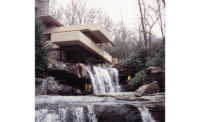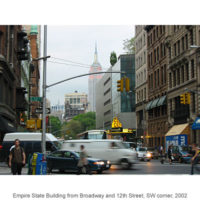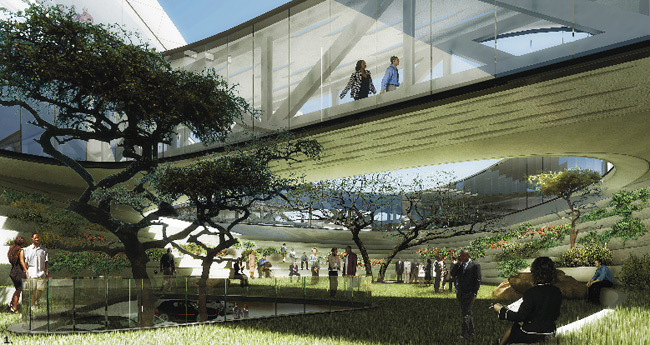Forward Thinking
Western-trained architects are designing housing, schools, and buildings for social services in Africa's expanding cities and its rural areas. Here's a look at a number of projects currently on the boards.

The Botswana Innovation Hub (BIH), will be a 320,000-square-foot center for research in technology and science. SHoP snagged the $100 million commission through a competition sponsored by Bostwana's government, with its plan for a sustainable series of interconnected offices and laboratories; the BIH is designed to be the country's first LEED-certified structure. Government officials, who are still raising construction funds, hope the building will spur growth in the country's tech sector, decreasing the nation's economic dependence on diamond mining by providing a place for local and foreign entrepreneurs to incubate ideas and interact.
Image courtesy Shop Architects

The Botswana Innovation Hub (BIH), will be a 320,000-square-foot center for research in technology and science. SHoP snagged the $100 million commission through a competition sponsored by Bostwana's government, with its plan for a sustainable series of interconnected offices and laboratories; the BIH is designed to be the country's first LEED-certified structure. Government officials, who are still raising construction funds, hope the building will spur growth in the country's tech sector, decreasing the nation's economic dependence on diamond mining by providing a place for local and foreign entrepreneurs to incubate ideas and interact.
Image courtesy Shop Architects

The Botswana Innovation Hub (BIH), will be a 320,000-square-foot center for research in technology and science. SHoP snagged the $100 million commission through a competition sponsored by Bostwana's government, with its plan for a sustainable series of interconnected offices and laboratories; the BIH is designed to be the country's first LEED-certified structure. Government officials, who are still raising construction funds, hope the building will spur growth in the country's tech sector, decreasing the nation's economic dependence on diamond mining by providing a place for local and foreign entrepreneurs to incubate ideas and interact.
Image courtesy Shop Architects

The Botswana Innovation Hub (BIH), will be a 320,000-square-foot center for research in technology and science. SHoP snagged the $100 million commission through a competition sponsored by Bostwana's government, with its plan for a sustainable series of interconnected offices and laboratories; the BIH is designed to be the country's first LEED-certified structure. Government officials, who are still raising construction funds, hope the building will spur growth in the country's tech sector, decreasing the nation's economic dependence on diamond mining by providing a place for local and foreign entrepreneurs to incubate ideas and interact.
Image courtesy Shop Architects

The Botswana Innovation Hub (BIH), will be a 320,000-square-foot center for research in technology and science. SHoP snagged the $100 million commission through a competition sponsored by Bostwana's government, with its plan for a sustainable series of interconnected offices and laboratories; the BIH is designed to be the country's first LEED-certified structure. Government officials, who are still raising construction funds, hope the building will spur growth in the country's tech sector, decreasing the nation's economic dependence on diamond mining by providing a place for local and foreign entrepreneurs to incubate ideas and interact.
Image courtesy Shop Architects

The Botswana Innovation Hub (BIH), will be a 320,000-square-foot center for research in technology and science. SHoP snagged the $100 million commission through a competition sponsored by Bostwana's government, with its plan for a sustainable series of interconnected offices and laboratories; the BIH is designed to be the country's first LEED-certified structure. Government officials, who are still raising construction funds, hope the building will spur growth in the country's tech sector, decreasing the nation's economic dependence on diamond mining by providing a place for local and foreign entrepreneurs to incubate ideas and interact.
Image courtesy Shop Architects

Former Senegalese president Abdoulaye Wade commissioned New York'based architect Fred Schwartz to design One Family, One Home, an 800-acre town plan with 3,600 units of affordable housing north of the capital city, Dakar. The new town will also provide parks, shopping, schools, and other services for a working-class population. Ground was broken for phase one in October 2011, and construction is under way.
Image courtesy Frederic Schwartz Architects

A rendering of the site, as it will appear from the air.
Image courtesy Frederic Schwartz Architects

A rendering of the site, as it will appear from the air.
Image courtesy Frederic Schwartz Architects

In the 1960s, California architect Steven Ehrlich was a Peace Corps volunteer in Africa, working for Morocco's Department of Urban Planning. After his service, Ehrlich traveled around the continent, living in Mali for a time and finally arriving in Zaria, Nigeria, to teach architecture at Ahmadu Bello University. In the mid-1970s he completed his first work on the continent, for the university, a clay-and-mud amphitheater that features bas-relief carvings in a traditional pattern.
Photo courtesy Steven Ehrlich Architects

In 2009 Ehrlich won a competition to build the New Abuja Gate City, a 98-acre complex and symbolic entryway into the new Nigerian capital, Abuja. Commissioned by the government and designed to resemble a traditional bow harp, the gateway is meant to symbolize national unity. Its packed program includes a reception hall, children's zoo, gymnasium, and marketplace. It's not clear when construction will begin on the project.
Image courtesy Steven Ehrlich Architects

New Abuja Gate City is a 98-acre complex and symbolic entryway into the new Nigerian capital, Abuja. Commissioned by the government and designed to resemble a traditional bow harp, the gateway is meant to symbolize national unity. Its packed program includes a reception hall, children's zoo, gymnasium, and marketplace. It's not clear when construction will begin on the project.
Image courtesy Steven Ehrlich Architects

New Abuja Gate City is a 98-acre complex and symbolic entryway into the new Nigerian capital, Abuja. Commissioned by the government and designed to resemble a traditional bow harp, the gateway is meant to symbolize national unity. Its packed program includes a reception hall, children's zoo, gymnasium, and marketplace. It's not clear when construction will begin on the project.
Image courtesy Steven Ehrlich Architects

New Abuja Gate City is a 98-acre complex and symbolic entryway into the new Nigerian capital, Abuja. Commissioned by the government and designed to resemble a traditional bow harp, the gateway is meant to symbolize national unity. Its packed program includes a reception hall, children's zoo, gymnasium, and marketplace. It's not clear when construction will begin on the project.
Image courtesy Steven Ehrlich Architects

New Abuja Gate City is a 98-acre complex and symbolic entryway into the new Nigerian capital, Abuja. Commissioned by the government and designed to resemble a traditional bow harp, the gateway is meant to symbolize national unity. Its packed program includes a reception hall, children's zoo, gymnasium, and marketplace. It's not clear when construction will begin on the project.
Image courtesy Steven Ehrlich Architects

The nonprofit Women for Women International (WFW ) commissioned New York architect Sharon Davis, who had worked with WFW in Kosovo, to design the Women's Opportunity Center. The 5-acre 'mini-village,' with classrooms, dormitories, and communal spaces, is meant for women survivors of the war in Rwanda. Canopies of corrugated metal sit atop circular bases of handmade brick, fired and produced by local women. WFW hopes to open the center on March 8, 2013, International Women's Day.
Photo courtesy Sharon Davis Design

The nonprofit Women for Women International (WFW ) commissioned New York architect Sharon Davis, who had worked with WFW in Kosovo, to design the Women's Opportunity Center. The 5-acre 'mini-village,' with classrooms, dormitories, and communal spaces, is meant for women survivors of the war in Rwanda. Canopies of corrugated metal sit atop circular bases of handmade brick, fired and produced by local women. WFW hopes to open the center on March 8, 2013, International Women's Day.
Photo courtesy Sharon Davis Design

The circular brick buildings that comprise Davis's scheme for the center are organized around a central courtyard, seen here.
Photo courtesy Sharon Davis Design

Roofs of corrugated metal top each circular classroom.
Photo courtesy Sharon Davis Design

Davis's plan.
Photo courtesy Sharon Davis Design

Existing site
Photo courtesy Sharon Davis Design

Phoenix-based architect Jack DeBartolo partnered with the nonprofit Engineer Ministries International to design the Shebraber School, a K'12 facility in this rural town near the Ethiopian capital, Addis Ababa. DeBartolo developed both a master plan and construction documents with a group of Arizona State University students of architecture and design. Now under construction, the library, community spaces, and school building are slated for completion in late 2013.
Photo courtesy DeBartolo Architects

DeBartolo developed both a master plan and construction documents for the Shebraber School with a group of Arizona State University students of architecture and design. Concept renderings show three areas of the complex designed for discrete activities.
Photo courtesy DeBartolo Architects

Proposed locations for various aspects of the master plan.
Photo courtesy DeBartolo Architects

A site schematic.
Photo courtesy DeBartolo Architects

A look inside several of the school's buildings.
Photo courtesy DeBartolo Architects

Building exteriors and outdoor spaces also each serve a specific purpose.
Photo courtesy DeBartolo Architects

Louise Braverman's plan for this 40-acre medical campus in Burundi, contracted by the nonprofit organization Village Health Works, includes a 29,000-square-foot women's health center, staff residences, and several other facilities. Though operating rooms require HVAC , the New York'based architect designed most of the buildings on site to be naturally ventilated, and the complex will produce its own electricity with photovoltaics and other energy sources. Phase one of construction'the staff residences'is scheduled for completion this fall.
Photo courtesy Louise Braverman Architect

This 40-acre medical campus in Burundi, contracted by the nonprofit organization Village Health Works, includes a 29,000-square-foot women's health center, staff residences, and several other facilities.
Photo courtesy Louise Braverman Architect

This 40-acre medical campus in Burundi, contracted by the nonprofit organization Village Health Works, includes a 29,000-square-foot women's health center, staff residences, and several other facilities.
Photo courtesy Louise Braverman Architect

This plan for a private international boarding school on 116 acres is modeled on a Maghreb military fortification, elevated and centered on a quad within its forested site (aerial view).
Photo courtesy Adjaye Associates

This plan for a private international boarding school on 116 acres is modeled on a Maghreb military fortification, elevated and centered on a quad within its forested site (elevation).
Photo courtesy Adjaye Associates

This rendered site plan shows the sprawling campus from the air.
Photo courtesy Adjaye Associates

Adjaye's design for a 52,000-square-foot five-star resort, commissioned by British-Ghanaian developer Soroma Capital, sits along Ghana's southern coast (below). It, too, draws on the country's history, incorporating a former German fort, built in 1683, that is now a World Heritage site.
Photo courtesy Adjaye Associates

This design for a 52,000-square-foot five-star resort, commissioned by British-Ghanaian developer Soroma Capital, sits along Ghana's southern coast. It draws on the country's history, incorporating a former German fort, built in 1683, that is now a World Heritage site.
Photo courtesy Adjaye Associates

This design for a 52,000-square-foot five-star resort, commissioned by British-Ghanaian developer Soroma Capital, sits along Ghana's southern coast. It draws on the country's history, incorporating a former German fort, built in 1683, that is now a World Heritage site.
Photo courtesy Adjaye Associates




































But many Western architects fail to see the potential. “People have very strong notions of Africa based on specific, singular images like famine and war,” says Bjarne Mastenbroek, whose Amsterdam-based firm, SeARCH, completed the Dutch embassy in Ethiopia in 2005. Increasingly, however, American architects are ignoring these misconceptions, working with not-for-profit foundations and government agencies to get commissions.
The most successful designs are those that don't just import stale Western ideas but respond to the local topography and culture. That's how New York–based design-build practice SHoP Architects landed the job to design the graphic, 320,000-square-foot Botswana Innovation Hub, a new center for technological and scientific research. Botswana's dry, hot climate and local basket-weaving tradition inspired aspects of SHoP's design, explains founding principal William Sharples. This project and a host of others—including a master plan for affordable housing in Senegal by New York–based Frederic Schwartz Architects and an opera “village” in Burkina Faso by native architect Diébédo Francis Kéré, who practices in Berlin—reflect the ambition of clients across the continent. One prolific client, the Aga Khan Development Network, which has raised the profile of Muslim architecture in Africa with a triennial award, has begun commissioning its own projects, including a university in development in Tanzania, with a master plan by Beyer Blinder Belle of New York and design by Weiss/Manfredi, also of New York, and Mexican firm Legorreta + Legorreta. Smaller but no less significant pro bono work for social initiatives—like Phoenix architect Jack DeBartolo's Shebraber School in Ethiopia or New York–based Sharon Davis's Women's Opportunity Center in Rwanda—points to an ethos of forward-thinking, inventive architecture on a variety of scales.
Such adventurous approaches don't mean there aren't serious challenges for architects who build in Africa. Simply transporting materials to a site can be a major stumbling block. Just ask Louise Braverman, who had rebar and other industrial goods unavailable in the small central African nation of Burundi shipped to the site of a new health complex from “as far afield as Dubai and Israel,” she reports. That's one reason why local design and building traditions often figure prominently in the work of Western architects in Africa. Increasingly, this is a way to meet the challenges posed by difficult climates and poor transportation infrastructure. In the years to come, the best of contemporary architecture on the continent is likely to be this hybrid of Western design and local construction methods, rather than an imposition of Western styles in the vein of the colonial era. The goal is “to break the gaps between the Western world and Africa,” says Mastenbroek of SeARCH. “We can create a dialogue through architecture.”








































